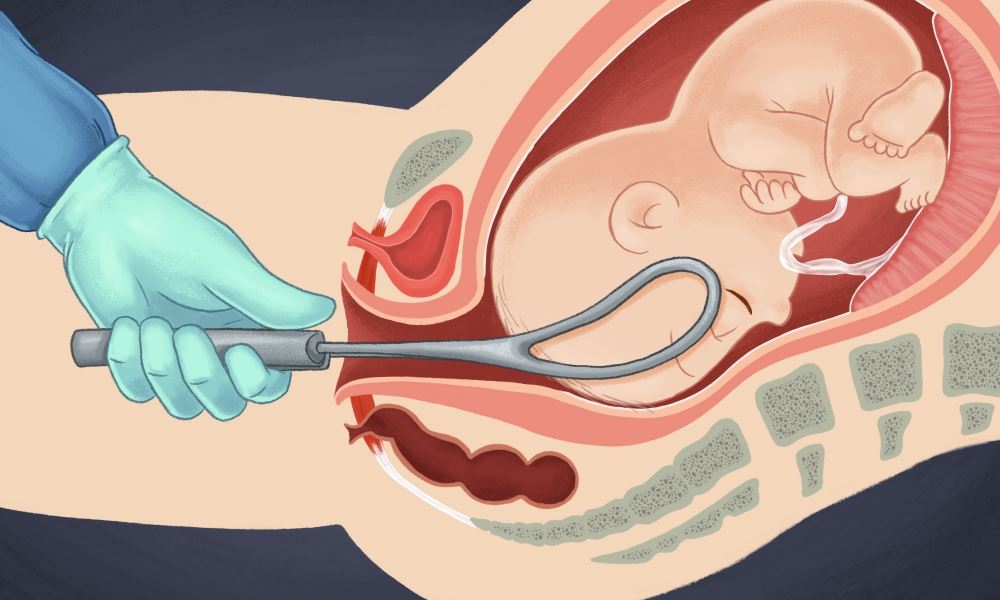Forceps Delivery - Assisted Vaginal Birth Procedure
A forceps delivery is a type of assisted vaginal delivery. It’s sometimes needed in the course of vaginal childbirth.
Forceps is an instrument consisting of 2 metal ladle-like devices, (shaped like a pair of large spoons or salad tongs with a curve to snugly fit around the baby’s head), which are maneuvered to cradle and grasp the baby’s head and help guide the baby out of the birth canal.

When is forceps delivery performed?
Forceps assisted vaginal delivery is done during the second stage of normal vaginal delivery:
» when the mother is pushing but the labour has stalled
» if immediate delivery is required due to foetal distress (indicated by a change in the baby’s heartbeat suggesting that the baby’s health is at risk)
» if the mother suffers from certain health conditions due to which she cannot push for long periods such as aortic valve stenosis, (narrowing of the heart’s aortic valve) blood pressure, aneurysm, glaucoma (if these health conditions are serious the doctor may recommend a caesarean procedure)
» if the baby is facing up (occiput posterior position) rather than down (occiput anterior position
How is forceps delivery performed?
Forceps delivery is done during the second stage of normal vaginal delivery. During this procedure:
» The doctor gently inserts two or more fingers inside your vagina and beside your baby’s head.
» The doctor then gently slides one part of the tong between the fingers and the baby’s head, followed by positioning of the other half of the tong on the other side of the baby’s head.
» Both parts of the tong are then locked together to safely secure the baby’s head in between them.
» If the baby is facing upwards, in between the mother’s contractions, the doctor uses the forceps to gently shift the position of the baby’s head
» As the labour progresses the doctor may remove the forceps before the widest part of the baby’s head goes through the birth canal or he/she may retain the hold of the forceps.
» When the mother experiences the next contraction, the doctor gently guides the baby through the birth canal using the forceps.
When is a forceps delivery not advisable?
Forceps delivery is not advisable if:
» The mother’s pelvis is small and the baby cannot fit through the pelvis
» The mother is 34 weeks pregnant
» The position of the baby’s head is not clear
» The baby is known to have health conditions such as bleeding disorders (such as hemophilia), or conditions that may affect its bones
» The baby is emerging buttocks/feet first (breech position)
» The baby is emerging shoulder first
» The size of the baby is big
» The baby’s head has not moved past the midpoint of the birth canal
» Include plenty of fibrous foods in your diet to avoid constipation. Use stool softeners as well.
» Drink plenty of water.
» Doing Kegel exercises during this period with doctor’s advice will help. It will tone your pelvic muscles and bring strength back to them.

What are the benefits of forceps delivery?
Studies show that forceps-assisted deliveries are associated with less failure than vacuum extraction which may be of critical importance with fetal distress.
Women who have instrumental vaginal deliveries (vacuum assisted or forceps-assisted vaginal deliveries) typically have a shorter hospital stay and fewer readmissions than women who have caesarean sections.
What are the risks of forceps delivery?
Forceps delivery has its risks for both the mother and the baby.
» The mother’s risks include:
» Vaginal tears during the delivery
» Bladder injuries
» Urethra injuries
» Post the delivery the mother may experience:
» Fecal and/or urinary incontinence
» Perineum pain
» Difficulty while urinating
» Anemia
» Weakening of the muscles supporting the pelvic organs
» The baby’s risks include:
» Bruising on the baby’s face due to the usage of forceps which disappears in a few days
» Nerve damage to the face caused by the pressure of the forceps
» Facial palsy
» Skull fracture
» Internal bleeding within the skull
» Temporary eye trauma for the baby due to the pressure of the forceps
» Seizures
After the procedure
After delivery, your health care provider will examine you for any tears that might have been caused by the forceps. Any tears will be repaired. Your baby will also be monitored for any signs of complications.

